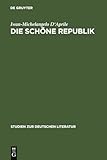Die schöne Republik : Ästhetische Moderne in Berlin im ausgehenden 18. Jahrhundert / Iwan-Michelangelo D'Aprile.
Material type: TextSeries: Studien zur deutschen Literatur ; 181Publisher: Tübingen : Max Niemeyer Verlag, [2012]Copyright date: ©2006Description: 1 online resource (222 p.)Content type:
TextSeries: Studien zur deutschen Literatur ; 181Publisher: Tübingen : Max Niemeyer Verlag, [2012]Copyright date: ©2006Description: 1 online resource (222 p.)Content type: - 9783484181816
- 9783110928600
- Aesthetics, German -- 18th century
- German literature -- 18th century -- History and criticism
- German literature -- Germany -- Berlin -- History and criticism
- Modernism (Literature) -- Germany -- Berlin -- History
- Berlin
- Geschichte 1790-1810
- Politische Philosophie
- Ästhetik
- LITERARY CRITICISM / European / German
- 111.85 22
- PT289 .D36 2006eb
- online - DeGruyter
- Issued also in print.
| Item type | Current library | Call number | URL | Status | Notes | Barcode | |
|---|---|---|---|---|---|---|---|
 eBook
eBook
|
Biblioteca "Angelicum" Pont. Univ. S.Tommaso d'Aquino Nuvola online | online - DeGruyter (Browse shelf(Opens below)) | Online access | Not for loan (Accesso limitato) | Accesso per gli utenti autorizzati / Access for authorized users | (dgr)9783110928600 |
Dissertation Universität Berlin 2003.
i-iv -- Inhalt -- 1. Einleitung -- 2. Moses Mendelssohn: Ästhetik als Kulturtheorie -- 3. Karl Philipp Moritz: Kunstautonomie und Ästhetik des Alltags -- 4. Ästhetik zwischen Popularphilosophie und Kantianismus: Herz, Maimon, Jenisch -- 5. Literarisierungen des Künstlers: Reichardt, Moritz, Wackenroder -- 6. Das politische Ästhetische in den Frühschriften Wilhelm von Humboldts -- Literatur -- Personenregister
restricted access online access with authorization star
http://purl.org/coar/access_right/c_16ec
In the late 18th century, aesthetic and political discourses were indissolubly interlinked. The aesthetic philosophies and literary fictions of authors like Karl Philipp Moritz, Salomon Maimon, Daniel Jenisch, Johann Friedrich Reichardt, or the young Wilhelm von Humboldt are both reflections and normative anticipations of the change from the largely court-dominated residential culture of the epoch of Frederick the Great to the emancipated urban culture of the Age of Reform. The topographical approach adopted in this study makes it possible to situate the discourses examined within the history of institutions and the media, and to understand them as argumentative strategies employed in actual debates. Concentration on one location and one restricted period of time also makes it easier to investigate the issue in a manner that cuts across both the dividing lines usually drawn between history, literature, and philosophy and the definition of epochs normally upheld in discussions of literary and cultural history.
Ästhetische und politische Diskurse standen im späten 18. Jahrhundert in einem untrennbaren Wechselverhältnis. Nicht nur wird politische Theorie im Gewand der Ästhetik formuliert, sondern ebenso wird die aus der Ästhetikdiskussion stammende Begrifflichkeit für gesellschaftskritische Gegenentwürfe fruchtbar gemacht. Das moderne Subjekt konstitutiert sich im deutschen Sprachraum so wesentlich als "Homo Aestheticus". Kommt dies bei Kant und Schiller theoretisch am avanciertesten zum Ausdruck, stellt sich der Vorgang in Berlin um 1790 systematisch weniger elaboriert, dafür aber praxisnäher dar. Die ästhetischen Entwürfe und literarischen Fiktionen von Autoren wie Karl Philipp Moritz, Salomon Maimon, Daniel Jenisch, Johann Friedrich Reichardt oder dem jungen Wilhelm von Humboldt sind sowohl Reflexionen als auch normative Vorwegnahmen des Wandels von der noch weitgehend höfisch dominierten Residenzkultur der friderizianischen Epoche zur emanzipierten Stadtkultur des Reformzeitalters. Der in der Studie verfolgte topographische methodische Zugang ermöglicht es, die untersuchten ideellen Diskurse institutionen- und mediengeschichtlich zu verankern und als Argumentationsstrategien innerhalb konkreter Debatten zu verstehen. Durch die lokale und temporale Konzentration lässt sich der Gegenstand zudem quer zur disziplinären Arbeitsteilung (Geschichte, Literatur, Philosophie) und zu literatur- und kulturgeschichtlichen Epochengrenzen untersuchen.
Issued also in print.
Mode of access: Internet via World Wide Web.
In German.
Description based on online resource; title from PDF title page (publisher's Web site, viewed 28. Feb 2023)


